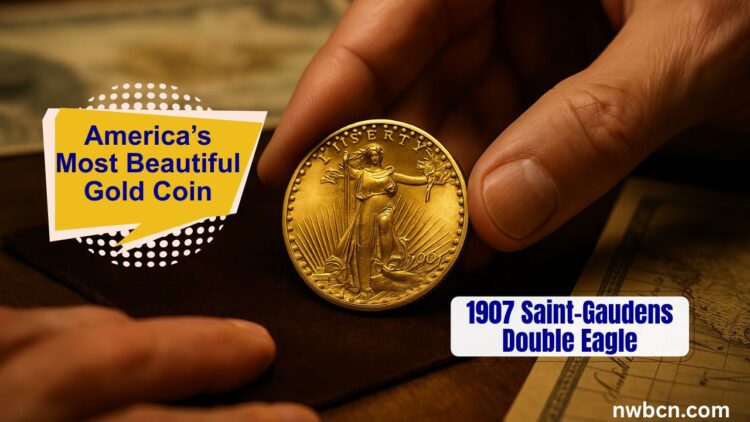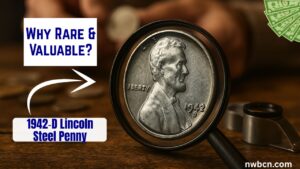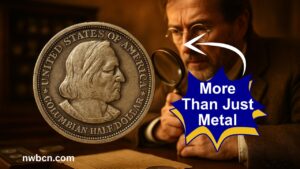The 1907 $20 Saint‑Gaudens Double Eagle, designed by sculptor Augustus Saint‑Gaudens under President Theodore Roosevelt’s direction, is widely regarded as the most aesthetically stunning U.S. coin ever minted.
But beyond its artistry lies a rich and sometimes tragic story: legal battles, rare proof and high-relief strike varieties, and the enduring legacy of a coin that changed American numismatics forever.
The Vision of a Theatrical Coin
- President Theodore Roosevelt aimed to elevate American coinage to the beauty of ancient Greek art. He enlisted sculptor Augustus Saint‑Gaudens, a renowned figure in the Beaux-Arts movement, to redesign domestic currency.
- High-relief prototype: In 1907, ultra-high relief strikes were produced using multiple impressions, but they were impractical—die wear, slow production, and difficulty ejecting coins. These were replaced in October 1907 by a more practical low-relief design.
- Design details:
- Obverse: Liberty strides forward, torch and olive branch in hand, crowned by radiant sun rays.
- Reverse: A majestic bald eagle in flight against the Capitol rising in the distance.
- In total, 53,272 high-relief proof coins were minted, alongside millions of low-relief circulation strikes.
Variants & Rarity: From Ultra-High to Proof
| Variety | Description | Mintage & Rarity |
|---|---|---|
| Ultra-High Relief (UH) | Bold, three-dimensional design – only early struck | ~12,000–15,000 estimated; very few survive in high grade. |
| Proof (High Relief) | Mirror-like finish – 1907 only | 53,272 total; strongest demand among collectors. |
| Low Relief (1907–1933) | Practical for circulation | ~40 million minted (1907–1933) – common in worn grades. |
Auction Records & Market Value
High-relief proofs and UH examples dominate records, but even low-relief mint-state pieces reach significant prices:
- 1907 UH high-relief PCGS MS-65+: $2.4 million (2021).
- 1907-A Proof (High-Relief) PCGS PR-68+: $2.3 million (2020).
- 1907 Low-Relief MS-65: $28,000+.
- Worn (VF–XF): $1,800–$5,000, depending on grade.
Historic and Cultural Significance
- Push for aesthetic excellence: Roosevelt’s reform brought art and national identity to everyday currency.
- Practical challenges: High-relief coins couldn’t be produced efficiently, prompting the 1907 low-relief redesign.
- FDR’s gold recall (1933): Most gold coins were recalled under executive order, but retained examples survive as bullion.
- Enduring symbol: The high-relief Double Eagle remains iconic—celebrated for artistry, craftsmanship, and historical resonance.
1907 Double Eagle Variants at a Glance
| Variety | Relief Type | Mintage | PCGS Value Range |
|---|---|---|---|
| UH 1907 Privy | Ultra-high | ~12k | $2M–$3M+ (if high grade) |
| Proof 1907 | High relief | 53,272 | $1.7M–$2.5M |
| Low-Relief 1907 | Standard strike | 527,500 | $1,500–$10,000+ (grade dependent) |
| 1908 onward low RFL | Circulation | ~40M | $1,200–$3,500+ (MS+ example) |
Authenticity, Grading & Collecting Tips
- Key indicators for UH & Proof: Sharp detail in hair strands, sun rays, and Capitol dome; mirror fields for proofs.
- Certification essential: PCGS/NGC labels for “1907 UHR” or “1907 High Relief Proof” confirm premium grade and authenticity.
- Avoid counterfeits: Replica gold-plated copies exist—always verify weight (33.436 g, .999 fine gold) and consult reputable dealers.
- Collecting strategy: Low-relief mint states are attainable; high-relief proofs warrant serious investment.
The 1907 Saint‑Gaudens Double Eagle is more than a coin—it’s a testament to American artistry, innovation, and transformation. From high-relief showpieces to circulating bullion, its variants record a unique intersection of art, diplomacy, and technological trade-offs. Whether in worn condition or starred mint state, this coin remains one of the most beautiful—and hauntingly elusive—symbols of U.S. history.
FAQs
Q1: What is the difference between high-relief and low-relief 1907 Daniel Eagle?
High-relief examples (proof and UH prototypes) feature pronounced depth and detail but were impractical to mass-produce. Low-relief versions were simplified in late 1907 for practicality, making them more common.
Q2: Are 1907 Saint‑Gaudens Double Eagles legal to own?
Yes. Though gold was recalled in 1933, collectors were allowed to retain prized and certified pieces in 1935, making modern ownership legal. The coins are now valued in private market.
Q3: How can I verify a genuine high-relief or proof Saint‑Gaudens dollar?
Use PCGS or NGC-graded slabs specifying “High Relief” or “Proof.” Examine details like sharp sun rays, full hairlines, and mirror-like fields. Authentic pieces weigh 33.436 g and are .999 fine gold.



